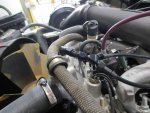It will get there because the level of water will equalize across the engine, but it will not flow as well due to the longer effective path for the coolant to take increasing resistance to flow. If you have two pipes of the same diameter hooked up to a common source, the shorter one will have a higher flow rate. If you run the hot water in a bathtub with the drain open below the faucet, your feet will be hotter than your shoulders.
If the temperature is hotter, then the pressure will be greater, and it will flow. Keeping the diameter of the return line small helps to do so. Note that the return lines tie in to the front crossover, before the coolant is returned to the radiator. Because there is a vacuum there, caused by the water pump moving coolant around and the flow is directed from the engine into the radiator at this point, and because the diameter of the crossover and the return to the radiator means the total area of the pipe back to the radiator is much larger than the two small lines running from the rear of the cylinder heads, coolant will not flow backwards because it will not move from a zone of lower pressure to a zone of higher pressure... that is impossible.
You could run incoming, cold coolant to the back of the block via lines to freeze plugs, but that would greatly complicate this system and introduce additional fragility. This system's design seems to take into account that the original engine cooling design was close, but not quite right, and that a little modification to ensure even flow out of the top (thus ensuring even flow from the bottom) would be sufficient. IMO the worst effect from such a system is no effect... a placebo. However, I doubt it has no effect. It's pretty obvious from the redesigns of the block that insufficient cooling to the rear cylinders is a known problem, and this is a logical, simple system that should help to address that.
I want to mention a couple more things. First, as engineers we don't need to know everything in exhaustive detail to know enough to make a decision. Given that the inventor is honest with his description of how he developed the system including sizing the return hoses based upon experimentation and measurement (the Scientific Method), it should be an improvement. So, really there are only two questions: do you trust the inventor to be honest about his approach to developing the system and on the results he obtained, and is it worth it to you specifically to spend around $300 with a minimal chance of doing harm and a non-minimal chance of making your engine last? Second, Sintorion, you have stated that you believe this kit is worthless at best (I don't believe you've asserted it could cause engine damage). Is it that you don't buy into the concept that the rear of these 6.2/6.5 engines has less coolant flow than the front, and thus the rear cylinders run hotter? Or that you don't believe this kit could possibly affect that?


